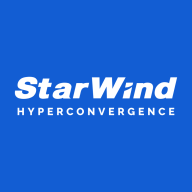


HPE StoreVirtual and StarWind HyperConverged Appliance compete in the storage solutions market. HPE StoreVirtual holds an edge due to its superior integration capabilities, especially with cloud systems.
Features: HPE StoreVirtual is known for its hardware compatibility, extensive support, and robust platform integration, particularly with Eucalyptus and VMware. Its high availability and simplicity are also notable. In contrast, StarWind HyperConverged Appliance offers an all-in-one solution with flexibility and ease of management, proactive support, and strong redundancy capabilities, although it doesn't match HPE's integration depth.
Room for Improvement: HPE StoreVirtual needs better scalability, flexible RAID options, more intuitive management interfaces, and improved partner selection. Users also reported issues with firmware updates and cluster capacity utilization. StarWind HyperConverged Appliance could enhance its monitoring tools, improve initial setup documentation, and offer more customization in system management while ensuring better communication during support processes.
Ease of Deployment and Customer Service: HPE StoreVirtual's deployment capabilities are adequate but may require expert handling in complex environments, and support can vary in consistency. StarWind HyperConverged Appliance offers straightforward deployment, excellent proactive support, and is praised for ease and speed, making it efficient for businesses prioritizing quick setup.
Pricing and ROI: HPE StoreVirtual involves significant upfront costs but provides good long-term value and requires careful licensing management to optimize costs. StarWind HyperConverged Appliance delivers a cost-effective solution ideal for limited budgets, noted for affordability compared to competitors, enhancing ROI by reducing additional costs through built-in features and support.
It does not require much management once you set up correctly, so it saves time, allowing an admin to focus on other work.
The support is done through email and is not that great, making it a very problematic area I've been dealing with for over four years.
I would rate them an eight out of ten.
Pure Storage FlashBlade is scalable.
In case there is any issue with any blade, the data is moved to another.
Technical support definitely needs significant improvement.
Its configuration should be easier.
The pricing of Pure Storage FlashBlade is expensive compared to other products I used from other companies in the past, but one benefit is that they have built-in ransomware protection.
The best features of Pure Storage FlashBlade include better throughput and better performance.
We can plug in many blades, and we can have data up to one terabyte.



FlashBlade is the industry’s most advanced scale-out storage for unstructured data, powered by a modern, massively parallel architecture to consolidate complex data silos (like backup appliances and data lakes) and accelerate tomorrow’s discoveries and insights.
HPE StoreVirtual storage ensures that organisations can optimise the benefits of server virtualisation with cost-effective high availability and disaster recovery. The iSCSI-based, scale-out storage platform is easy to manage and change – meeting ongoing business demands without creating IT bottlenecks or application downtime. Overcoming the cost and management limitations of traditional storage area networks (SANs), HPE StoreVirtual nodes use storage clustering to form a single pool of resources that enable organisations to buy only what they need today, scaling non-disruptively to meet requirements in the future.
For SMB, ROBO and Enterprises, who look to bring in quick deployment and operation simplicity to virtualization workloads and reduce related expenses, our solution is StarWind HyperConverged Appliance (HCA). It unifies commodity servers, disks and flash, hypervisor of choice, StarWind Virtual SAN, Microsoft Storage Spaces Direct or VMware Virtual SAN and associated software into a single manageable layer. The HCA supports scale-up by adding disks and flash, and scale-out by adding extra nodes.
StarWind HyperConverged Appliance consists of StarWind Virtual SAN, Microsoft Storage Spaces Direct or VMware Virtual SAN “Ready Nodes”, targeting those, who are building their virtualization infrastructure from scratch. In case there is an existing set of servers, we offer a “software only version”, which is essentially our years proven StarWind Virtual SAN. Basically, it’s the fuel powering StarWind HCA.
We monitor all Software Defined Storage (SDS) reviews to prevent fraudulent reviews and keep review quality high. We do not post reviews by company employees or direct competitors. We validate each review for authenticity via cross-reference with LinkedIn, and personal follow-up with the reviewer when necessary.